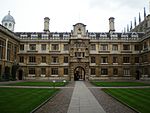Queens' College, Cambridge

Queens' College is a constituent college of the University of Cambridge. Queens' is one of the oldest colleges of the university, founded in 1448 by Margaret of Anjou. The college spans the River Cam with the Mathematical Bridge connecting the two sides. College alumni include Desiderius Erasmus, who studied at the college during his trips to England between 1506 and 1515. Other notable alumni include author T. H. White, Israeli politician Abba Eban, founding father of Ghana William Ofori Atta, newsreader and journalist Emily Maitlis, actor Stephen Fry, Governor of the Bank of England Andrew Bailey, and the British members of Parliament Stephen Kinnock and Liz Kendall. As of June 2016, the college held non-current assets valued at £111.18 million.The president of the college is the economist Mohamed A. El-Erian. Past presidents include John Fisher.
Excerpt from the Wikipedia article Queens' College, Cambridge (License: CC BY-SA 3.0, Authors, Images).Queens' College, Cambridge
Silver Street, Cambridge Newnham
Geographical coordinates (GPS) Address Nearby Places Show on map
Geographical coordinates (GPS)
| Latitude | Longitude |
|---|---|
| N 52.2019 ° | E 0.1147 ° |
Address
roof garden
Silver Street
CB3 9EU Cambridge, Newnham
England, United Kingdom
Open on Google Maps











